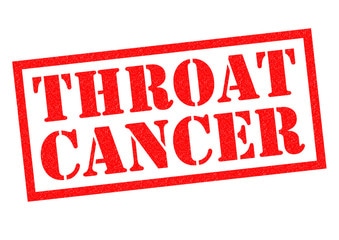Throat cancer
Throat cancer is a general term that usually refers to cancer of the pharynx and/or larynx. Regions included when considering throat cancer include the nasopharynx, oropharynx, hypopharynx, glottis, supraglottis and subglottis; about half of throat cancers develop in the larynx and the other half in the pharynx. Consequently, any cancers (growth and/or spread of abnormal cells that form tumors or metastasize) that develop in these regions of the throat are considered throat cancers.
Causes
Throat cancer occurs when cells in your throat develop genetic mutations. These mutations cause cells to grow uncontrollably and continue living after healthy cells would normally die. The accumulating cells can form a tumor in your throat.
It’s not clear what causes the mutation that causes throat cancer. But doctors have identified factors that may increase your risk.
Types of throat cancer
Throat cancer is a general term that applies to cancer that develops in the throat (pharyngeal cancer) or in the voice box (laryngeal cancer). The throat and the voice box are closely connected, with the voice box located just below the throat.
Though most throat cancers involve the same types of cells, specific terms are used to differentiate the part of the throat where cancer originated.
- Nasopharyngeal cancerbegins in the nasopharynx — the part of your throat just behind your nose.
- Oropharyngeal cancerbegins in the oropharynx — the part of your throat right behind your mouth that includes your tonsils.
- Hypopharyngeal cancer (laryngopharyngeal cancer)begins in the hypopharynx (laryngopharynx) — the lower part of your throat, just above your esophagus and windpipe.
- Glottic cancerbegins in the vocal cords.
- Supraglottic cancerbegins in the upper portion of the larynx and includes cancer that affects the epiglottis, which is a piece of cartilage that blocks food from going into your windpipe.
- Subglottic cancerbegins in the lower portion of your voice box, below your vocal cords.
Symptoms
Signs and symptoms of throat cancer may include:
- A cough
- Changes in your voice, such as hoarseness or not speaking clearly
- Difficulty swallowing
- Ear pain
- A lump or sore that doesn’t heal
- A sore throat
- Weight loss
Homoeopathic Treatment
The scope of Homeopathy for cancer management varies depending on the type of cancer, stage of cancer and the general health of the patient. Following are some of the aspects of Cancer management with Homeopathy:
- One of the most distressing complaints associated with some varieties of Cancer is the agonizing pain. Conventional medicines can provide pain relief but only to a certain extent and these medicines are not without any side effects. Moreover there is always a restriction to the dosage that can be safely administered to the patient. The advantage of administering Homeopathic medicines in such cases is that there can be effective pain control without inducing any side effects.
- Homeopathy can help in improving the general well being and vitality of the patient.
- Conventional treatment options for cancer (chemotherapy, radiotherapy, etc) are associated with distressing side effects and homeopathy can play a definitive role to counter these side effects.
- The diagnosis of cancer often leaves the patient with a sense of depression, anxiety and fear. The treatment may induce additional irritability, impatience and mood fluctuations. Homeopathy can influence the psyche of the patient and help him to deal with these emotions in a better way.
- Homeopathic medicines may also have a role to play in controlling the pace at which the disease increases and spread of the disease to other organs.
Homeopathic medicines can also be administered along with the allopathic medicines.

